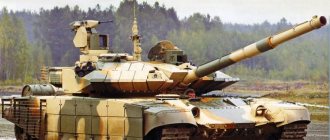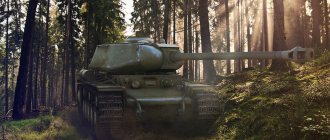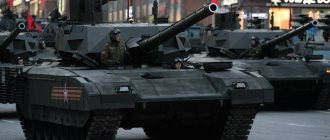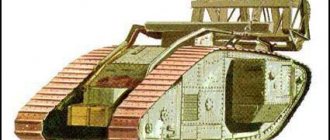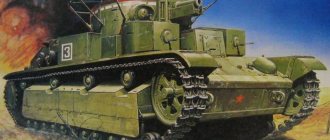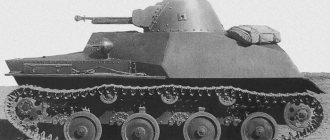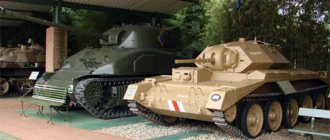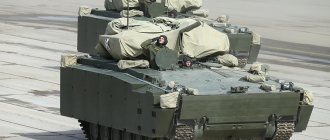Photo: Uralvagonzavod
Uralvagonzavod, part of Rostec, continues to supply modernized T-90M Proryv tanks. The vehicles received a fundamentally new turret and a more powerful engine. Thanks to the multi-channel sight, tanks can be used at any time of the day, and the ability to exchange data with other vehicles and other innovations bring the T-90M closer to the latest generation tanks. According to the military, who have already gotten acquainted with the new model, today the T-90M “Breakthrough” is the most modern tank in the Russian army. We talk about the history of creation and features of the “breakthrough” machine.
A little history
It is known that the T-90AM tank is a direct descendant of the T-90, the development of which began back in 2004. The export version of the product, called the T-90MS, was presented to the public in 2011. During production, the product was assigned such markings as “Object 188MS”, R&D “Proryv-2”, as well as T-90S (T-90MS).
The tank was conceived as the embodiment of advanced military technologies in the field of balancing combat and technical characteristics. The capabilities of the new combat unit make it possible to conduct military operations in any climatic conditions, at any time of day and carry out assigned combat missions that correspond to modern realities of combat.
Device
The T-90AM tank has a V-shaped engine consisting of twelve cylinders, produced at the Chelyabinsk Tractor Plant. The engine is four-stroke and is marked V-92S2F. It differs from its predecessors in the quality of casting, connecting rods and pins of increased strength, reinforced pumps, crankcases and injectors.
Nitriding technology was used in the production of the crankshaft. The essence of the method is to coat the surface of parts with an alloy saturated with nitrogen, which can significantly increase resistance to corrosion and wear. In case of malfunction of the T-90AM tank engine, the crew is notified.
Innovative methods were also embodied in the implementation of the principles of nutrition of the V-92S2F. The engine is diesel and is capable of starting at a minimum temperature of −20 °C. However, it is believed that the operating temperature range varies from −50 °C to +50 °C.
Highlights
The T-90AM has several design features.
Firstly, this is the location of the exhaust system in the pipes above the tracks. This is due to the desire of the designers to reduce the temperature of the body, which significantly complicates the task for location systems of a mock enemy operating on the basis of thermal energy recognition. For example, infrared guidance systems for missiles of various classes.
Secondly, for the successful operation of the T-90AM, the Russian army implemented a control system based on a steering wheel - similar to the system of aircraft and watercraft. The gearbox implies both an automated mode of operation and a transition to manual control.
Thirdly, the surveillance system has been modernized, including a modern set of night vision devices for the driver and video cameras for viewing from the rear.
Booking
The T-90AM is partially equipped with Afghanit active protection units. It is a set of measures to aggressively counter the enemy in the event of an attack by a combat unit.
The Afghanit complex itself includes short- and long-range pulse-Doppler radars, ultraviolet direction finders, as well as a robotic controlled machine gun mount to counter incoming ground-to-ground and air-to-ground projectiles.
The Afghanit is fully equipped on the T-14 of the Armata family, partial installation, as mentioned above, is on the T-90AM, and on the export version of the T-90MS it is possible to integrate the Arena-E system, which is in many ways similar above, but has significant functional limitations. Thus, all the splendor of advanced technologies will not be exported, and all the benefits will be enjoyed by members of the T-90AM crew in the Russian army.
"Relic"
Separately, it should be mentioned that domestic designers have abandoned the use of Kontakt-5 protective equipment, previously used for such models as T-90, T-90A, T-90S, starting in 1988.
The Relikt modular complex is a third-generation dynamic defense system designed to counter modern sub-caliber projectiles. For example, the Western-made M829. Installation on the T-90AM tank is also provided.
The system is based on the principle of “double throwing”, according to which two armor plates are fired at once towards an approaching projectile, thus reducing the damaging effect significantly. Advantages of the Relikt system using the example of the T-90AM Proryv:
- simplicity of design and operation, making it possible to easily replace or repair failed parts;
- the frontal armor of the turret has a significantly higher percentage of overlap (up to 68% compared to 45% for its predecessor);
- the possibility of further modernization is provided by simply replacing dynamic protection elements with modernized options;
- the transition from Contact-5 does not require the installation of additional equipment.
Protection
The Relikt dynamic protection installed on the tank provides protection against cumulative and armor-piercing sub-caliber projectiles, and the Relikt modular system allows not only to replace damaged elements, but also, over time, to re-equip the tank’s protection with more modern armored materials. This is perhaps the best security system in the world today. As the developers of the system from JSC Research Institute of Steel assure, in the frontal projection the T-90AM tank cannot be hit by any of the existing anti-tank weapons.
The tank's turret module is protected by anti-fragmentation fire-resistant material such as Kevlar instead of the fire-hazardous anti-neutron lining, and the fire extinguishing system has also been improved. To protect the engine and transmission compartment of the tank from cumulative ammunition, lattice screens were installed.
Thus, the T-90AM tank received increased firepower and enhanced protection, became more mobile, while its dimensions remained the same, and its weight was only 48 tons, which is significantly less than its German and American counterparts.
Armament
The Soviet model of the D-81TM gun (GRAU index - 2A46), produced once in 1970, has undergone modernization a significant number of times. The model marked 2A46M-5 was developed for the T-90AM tank. The technical characteristics allow the gun to be installed on both the T-90 and the progenitor of the series, the T-72. Moreover, the re-barrel does not require the mandatory dismantling of the tank turret.
Compared to previous models, the 2A46M-5 shoots 20% more accurately, and the accuracy and rigidity of the product design itself have been improved. In addition, the automatic loader already carries 22 shots. The remaining parts of the ammunition are located both inside the product and outside.
The Proryv kit includes a 7.62 mm guided anti-aircraft gun. The commander's ability to search for targets has also been improved and refined, making targeting easy both at night and during the day.
Main nodes
- Chassis. The T-90 tank introduced the concept of “Flying tank”, jumping from a 2 m springboard, it lowers its bottom to almost the entire clearance height of 49 cm and makes a second jump without stopping, continuing to move. The comb passes at full speed. No one except the Nizhny Tagil car can withstand such a load on the hydraulics and torsion bar suspension. In the desert, it easily passed through 20 cm layers of dust. It overcomes a vertical wall 1 m high and easily rises up at an angle of 300.
- Frame. T-72 hull design, barrel dimensions*length*width (9530x6860x3795 mm), turret height 2280mm. The predecessor became famous for its survivability and transferred it to the T-90. The design is protected by several stages: built-in dynamic protection (35 years ago, mounted ones were also effectively used, but the tragedy in the Chechen War of 1994 was that the soldiers were sent into battle without it). The tank can withstand dozens of hits from all types of foreign tanks, RPGs and ATGMs and return to duty. The unfortunate placement of the turret barrel above the driver's hatch does not cause any practical harm. If the vertical guidance hydraulic drive is damaged (the barrel rests on the hatch), the breech will rest against the turret hatch and make room for the driver to quickly leave the tank. A fire that breaks out in the turret will ignite the charges in 30 seconds (the worst case scenario, generally 15 - 20 minutes), and it’s easy to get out of the T-90. This is all from the practice of the combat T-72.
- Engine. Engine V-92S2F with a power of 1130 hp. – this is the latest modification of a durable engine running on diesel fuel, kerosene, gasoline (as well as sunflower oil, alcohol, etc.). There is plenty of power for a machine weighing 48 tons; there is a reserve reserve for weighting, if necessary.
Read BMP-3M Dragoon combat unit - the best armor for going on the attack
Communications and surveillance
It is known that the T-90AM has a turret with the Kalina multifunctional complex, which was first announced as an innovative development for the T-90.
Key details of the system:
- commander's panoramic sight "Hawkeye";
- automated target tracking system;
- gunner's sight "Sosna-U", which includes a laser range finder and thermal imager;
- complex of tactical level control systems;
- target recognition functionality based on the “friend/foe” principle;
- software for interaction between combat units within a battalion;
- complex for controlling smoke screens;
- terrain orientation system based on GPS and GLONASS;
- radio equipment for internal communication and external interaction.
Evolutionary leaps
The T-90 tank entered service back in 1992, as a result of the modernization of the T-72. Since then, the combat vehicle has earned respect both in the ranks of the Russian army and abroad.
Meanwhile, the modernization of the T-90 did not stop for a minute. Both the firepower indicators and the armor and mobility coefficients of the combat unit grew upward. Research work (abbreviated as R&D) called “Breakthrough” aimed to create a universal type of weapon capable of rushing into the heat of battle and emerging victorious.
Russian designers have long abandoned imitation of the West in terms of implementing military equipment projects, and this is what happened with the T-90AM tank. Analogues of a product can only be predecessors that are somewhat similar, or modernized versions (for the same reason). Significant differences between the Proryv (T-90MS) and its predecessors were described above - these are a re-equipped surveillance system, weapons and booking principles.
The second “Breakthrough” (T-90AS) is distinguished by its external characteristics: it has a welded turret, the upper part of the frontal armor of which has been significantly strengthened.
The T-90AM "Breakthrough-3" also has minor external differences: the developers paid more attention to the armor of the tracks, lengthening the side armor plates, providing protection for moving parts. An important aspect is the installation on the “third breakthrough” of a gun model marked 2A82-1M, whose wear resistance is designed for 900 rounds. The same model is installed on the T-14 combat platform of the Armata family.
Predecessor history
The tradition of winning was laid down in the T-90SM by its predecessor, the T-72. Who else should we take an example from? And how many reservists and volunteers from all over the world (knowing the T-72 and T-90) can help Russia in difficult times. The modern “Breakthrough” was created on the basis of the T-72 tank, proven in numerous battles. He is the winner of the Iran-Iraq War (1980 – 1988), where the British “Chieftain” and “Scorpion”, the American M47, M60A1 were no competition to him (Iraq acquired 1100 T-72/M/M1 from the USSR, which won all the battles, The Iranian military recognized the complete superiority of our tanks in battles). In Lebanon in 1982, Israel received a rebuff from Syria, losing to the T-72 tank. As a result, Libya, Syria and Iraq (the Iraqis called the T-72M1 “Lion of Babylon”) received licenses and produced these machines for themselves.
It was precisely the advantage of the combat and operational characteristics of tanks produced in the USSR that led to the appearance of the fundamentally new M1A1/NA tank by the Americans. In Desert Storm, the United States responded to the Iraqi invasion of Kuwait only six months later, replacing the M1/IP with Abrams during this time (the Iraqis did not have a Soviet shell for penetrating depleted uranium armor for the T-72M1; night tank battles were fought , because during the day the sky was controlled by American aviation. In night battles, thermal imagers installed on US tanks became an advantage.) But the advance of American tanks deeper into Iraq was stopped at their borders due to the large number of Abrams losses. Iraq had experience in countering the 120 mm English L11A5 cannon, and produced a welded screen for the frontal parts of its vehicle. They also used a French-made fire protection system and a Chinese anti-optical generator (analogous to the “Curtain” then available in the USSR).
The T-72 has been tested in other wars: it fought in Yugoslavia (1991-1995; 1998-2001), Chechnya (1994 - 1995), Nagorno-Karabakh (1991-1994), Sri Lanka and Somalia (1997) , South Ossetia (2008), Libya (2012), Sudan (2012) and today in Syria. All the time, combat experience was analyzed and taken into account by the designers of Uralvagonzavod when creating new modifications. In 1991, the latest modification of the T-72BU was created; in 1992, it appeared in the army as the T-90.
Read BTR-90 Rostock
More about the “third breakthrough”
It is known that the T-90AM “Proryv-3” tank was renamed T-90M after completion of R&D. The ammunition load includes 45 shells, some of which are already located in the loading system, and the other in the rear of the tank’s turret. This is due to the fact that the product is designed to perform tasks in urban conditions (for this, the shells are positioned ready to be fed into the barrel) and in open areas.
In addition to the aforementioned ammunition, the “third breakthrough” weapon set includes a 9M119M missile, which is used to disable modern enemy tanks at a range of up to 5 kilometers.
Tank for commanders
Back in Soviet times, UKBTM received the task of developing, on the basis of Object 188, its command version, which was supposed to provide control of subordinate units during combat operations both day and night, as well as communication with higher commanders.
The tank received the name T-90K (commander's) and was equipped with special equipment - a short-wave radio station R-163-50K ("Crossbow-50K"), tank navigation equipment TNA-4-3, a telescopic antenna mast, a PAB-2M artillery compass and an AB electrical unit -1-P with a power of 1 kW, which serves to provide power to the equipment during parking, with the tank engine turned off. With an 11-meter mast antenna, the shortwave radio station R-163-50K provides stable communication at a range of up to 350 km.
Despite the fact that a significant number of additional units of the fire control system and communications equipment had to be installed on the command vehicle, the combat characteristics of the T-90K were maintained at the level of the linear T-90.
TTX
It is worth mentioning the tactical and technical characteristics of the T-90AM. The combat vehicle has a mass of 48 tons, the crew consists of three people: a gunner, a driver and a signalman.
Both mentioned guns (2A46M-5 and 2A82-1M), mounted on the product model, are smooth-bore and have a caliber of 125 mm. The firing range of sub-caliber armor-piercing projectiles reaches 3 km. If an attack is made with an anti-tank guided missile (the aforementioned 9M119M), then the target can be hit at a distance of 5 km.
An additional Reflex-M weapon was also installed, designed to combat pillboxes, enemy tanks and helicopters.
The tank is capable of reaching speeds of up to 70 km/h on the highway and approximately 45 km/h over rough terrain.
"Reflex-M"
According to the GRAU index, the product is marked 9M119M. NATO also assigned its own classification - AT-11 Sniper. The projectile is a solid fuel rocket.
The warhead of the Invar or Invar-M projectile is cumulative. Inside the warhead there are two charges: the base and the leading. The principle of operation is as follows: first, the element of dynamic protection placed on the path between the armor of the enemy structure and the flying projectile is destroyed, then the armor is directly penetrated.
The Invar product was put into service in 1992, and the Invar-M in 1990. There is also a version for destroying enemy personnel - with a thermobaric effect.
The composition of "Reflex-M" is as follows:
- Two shots of an Invar or Invar-M anti-tank guided missile for a 125 mm smoothbore gun (the term “shot” in the army means the projectile itself).
- Static voltage converter labeled 9S831.
- A guidance device with a built-in rangefinder “Irtysh”, which includes an information block.
- Automation unit 9С517-1С, which is responsible for collecting information about the controlled combat unit, intended to carry out assigned combat missions.
Tanks
IS-3. Heavy breakthrough tank. (THE USSR). Description, images, characteristics.
IS-3 - Soviet heavy tank (Object 703). This tank was the last Soviet heavy vehicle accepted into service and put into mass production during World War II. While maintaining the armament of the IS-2 tank, the IS-3 has a new design for the armor of the bow, a manhole has been introduced above the driver's seat, and inspection slots in the upper front plate have been eliminated.
The original design of the welded hull and cast turret significantly increased armor protection compared to the IS-2, from which many components and assemblies were borrowed into the IS-3 modification. A 12.7-mm DShK anti-aircraft machine gun, a 10-RK-26 radio station, a TSh-17 tank sight and means for setting up an MDS smoke curtain were installed. Between 1945 and 1946, more than 2,300 combat vehicles of this type were produced.
The IS-3 heavy tank was created as part of the IS-2 modernization program adopted in April 1944. The design of the new vehicle was carried out by ChKZ designers under the general leadership of N.L. Dukhov, M.F. was appointed project manager. Balzhi.
IS-3. Heavy breakthrough tank. (THE USSR). Description, images, characteristics.
The main requirements were to increase security. It was necessary to replace the cast structure of the bow with a welded one, “ensuring that in the operating position of the tank it is impenetrable with armor-piercing and sub-caliber shells from the guns of the Tiger and Panther tanks from all distances.” The turret, as the most vulnerable point of the IS-2, also needed improvement.
From December 18 to December 24, 1944, state tests of the IS-3 (“Kirovets-1”) took place at the NIBT test site. The tests were carried out by running and firing from the Shershen and ISU-122 self-propelled guns with an armor-piercing projectile from a distance of 600-800 m. While moving, the tank behaved satisfactorily; during shelling it showed that the upper frontal plate of the hull was not penetrated by an 88-mm armor-piercing projectile from 350 m ( the shell left a dent 28 mm deep), and a 122 mm armor-piercing shell from a distance of 690 m (the shell left a dent 35 mm deep). But the forehead of the turret was pierced by an 88-mm armor-piercing shell from a distance of 300 m, and the side and stern from 1000 m.
The results of the test report stated: “The IS-3 tank passed the 500 km field test, but failed the 1000 km warranty test due to fan failure at 810 km. In terms of performance and reliability, the IS-3 tank is equivalent to the IS-2 tank. The shelling of the hull showed clear advantages in armor penetration compared to the IS-2 hull. The modernized model of the IS-3 tank is recommended for adoption with the elimination of the shortcomings noted in the report.”
IS-3. Heavy breakthrough tank. (THE USSR). Description, images, characteristics.
When developing the IS-3 project, the findings of a commission that examined combat damage received by tanks during the Battle of Kursk in front-line conditions were taken into account. Attention was drawn to the massive nature of the destruction of combat vehicles in the frontal part of the hull and turret. It took some time to arrive at the optimal shape of the hull and turret. The IS-2 modernization project was also developed by plant No. 100. It was its designers who proposed the gable “pike” bow that later became famous.
On the vehicle developed by the ChTZ design bureau, the nose of the vehicle was straightened, like the T-34, but the tank received a new turret, which was a single casting in the form of a spherical segment, the thickness of which in the frontal part reached 230 mm. For a number of reasons, development was delayed. After a long consideration of both projects, it was decided to combine both projects and instruct the Kirov Plant to develop a heavy tank based on them, using the advantages of both designs. All these proposals made it possible to create a vehicle similar to the weight of the IS-2 and at the same time increase its armor resistance by more than two times.
Taking into account the experience of military operation of IS tanks, the design of the chassis, power plant and transmission on the IS-3 was left unchanged. The hull was welded from rolled armor plates and did not have cast armor parts. The design of the gable inclined nose made it possible to resolve the issue of placing the driver's hatch (on previous models of IS tanks there was no hatch), significantly improve visibility from the driver's seat in the "stowed" position and ensure high armor resistance of the frontal part of the hull. During testing, the 88-mm armor-piercing projectile did not penetrate the frontal part of the hull even from a distance of 100 m. To reduce the fire hazard, the fuel tanks were moved from the fighting compartment to the engine compartment.
IS-3. Heavy breakthrough tank. (THE USSR). Description, images, characteristics.
The tank's armament remained the same: a 122-mm D-25 cannon and a coaxial 7.62-mm DT machine gun; a 12.7-mm DShK anti-aircraft machine gun was installed on the turret roof. The forward and stern machine guns were missing.
Interestingly, the IS-3 had a turret rotation mechanism. The electric drive was equipped with a commander's control system. The commander could, keeping the target in the field of view of his viewing device, press a button mounted on the device and turn the turret in a given direction along the shortest path. When the line of sight coincided with the axis of the gun barrel, the turret stopped.
The plant was able to send the first IS-3 for testing only in February 1945. Based on their results, the tank was recommended for mass production after the identified deficiencies were eliminated.
On December 30, Supreme Commander-in-Chief I.V. Stalin gave the go-ahead to the creation of a new heavy tank in the weight category with IS-122 armament and with doubled armor protection so that the hull of the new tank would not be penetrated by the most powerful 88-gun at that time. mm anti-tank gun mod. 1943 at heading angles up to 60°.
On February 20, 1945, the reference model IS-3 (“Object 703”) No. 2 went for state tests, which took place at the NIBT test site, from March 23 to April 12, 1945. The IS-3 N9 3 tank arrived at the test site on March 26, and On May 21, the head of the technical department of the GBTU of the Red Army, Blagonravov, signed a set of technical documentation for the IS-3 tank, thus initiating mass production of the said tank, the real life of which began after the Victory.
IS-3. Heavy breakthrough tank. (THE USSR). Description, images, characteristics.
By May 1, 1945, ChKZ had produced only 25 units. IS-3, some of which were still undergoing factory testing.
The IS-3 tank was late for the war. By the time the Act of Surrender of Germany was signed, all tanks were still at the factory and did not take part in hostilities. They also did not participate in the battles in the Far East in August - September 1945. Only on September 7, 1945, the tank regiment, which was armed with these combat vehicles, took part in the parade of Red Army units in Berlin.
Characteristics:
- Heavy breakthrough tank.
- Combat weight, t: 49;
- Layout scheme: classic;
- Crew, people: 4;
- Developer: KB ChTZ;
- Years of production: 1945-1946;
- Years of operation: 1945-1969;
- Number of issued, pcs.: 1555;
- Case length, mm: 6900;
- Length with gun forward, mm; 9850;
- Case width, mm: 3150;
- Height, mm: 2450;
- Ground clearance, mm: 450;
- Armor type: Cast and rolled steel. Body forehead (top), mm/deg. — 110 / 72°. Body forehead (middle), mm/deg. — 110 / 55°+43° (Double tilt). Body forehead (bottom), mm/deg. - 110 / 63°. Hull side (top), mm/deg. — 90 /60° + 30 / 30°. Hull side (bottom), mm/deg. — 90 / 0..60°. Hull stern (top), mm/deg. — 60 / 48°. Hull rear (bottom), mm/deg. - 60 / 41°. Bottom, mm - 20. Hull roof, mm - 20. Turret forehead, mm/deg. — 250. Gun mask, mm/deg. — 250. Tower side, mm/deg. — 110…220 / 0…60°. Tower feed, mm/deg. — 110…220 / 0…60°. Tower roof, mm - 20 / 82...90°.
- Caliber and brand of gun: 122 mm D-25T mod. 1943;
- Gun type: rifled tank gun;
- Barrel length, calibers: 48;
- Gun ammunition: 28;
- Angles VN, degrees: -3…+20°;
- GN angles, degrees: 360°;
- Firing range, km: about 15;
- Sights: telescopic articulated TSh-17, Hertz panorama, side level;
- Machine guns: 1 × 12.7 mm DShK, 1 × 7.62 mm DTM;
- Engine type: V-11-IS3;
- Engine power, l. p.: 520;
- Highway speed, km/h: 40;
- Speed over rough terrain, km/h: 16 on virgin soil;
- Cruising range on the highway, km: 315;
- Cruising range over rough terrain, km: 150 on virgin soil;
- Specific power, l. s./t: 11.2;
- Suspension type: individual torsion bar;
- Specific ground pressure, kg/cm²: 0.85…0.87;
- Climbability, degrees: 32;
- Climbable wall, m: 1.0;
- Ditch to be overcome, m: 2.5;
- Fordability, m: 1.4.
In the army
The T-90AM tank represents an innovation in the domestic defense industry. It serves as further proof that military design ideas do not stand still and the modernization of previously implemented projects does not stop for a minute.
There is no exact information about how many T-90AMs are currently in the Russian army (this information is at least secret). However, there are references to the fact that a certain number of “third breakthroughs”, that is, T-90M, have been ordered. And this is logical! It is stupid to use a conditionally undeveloped version of the T-90AM in the Russian army if an advanced model already exists.
At the beginning of the journey
The history of the T-90 began in the mid-80s - back during the “great and indestructible” Soviet Union. Then, in the Ministry of Defense (MoD) and in the Ministry of Defense Industry (MOP) of the USSR, a completely sensible idea prevailed about the need to develop a single promising main tank for the entire Soviet Army. With its adoption, an extremely unique period of Soviet tank building was supposed to end, when factories were simultaneously producing two or three types of main tanks - T-64, T-72 and T-80. They were similar in combat characteristics, but differed significantly in design, which extremely complicated the process of their operation in the army due to the de-standardization of the tank fleet.
In accordance with the Government Decree “On measures to create a new tank” issued on February 7, 1986, the Kharkov T-80UD was to serve as the basis for it. It was an improved “eighty” with a compact two-stroke diesel engine 6TD instead of the expensive and power-hungry gas turbine GTD-1000. Gradually, the T-80UD would replace other types of tanks in the army. It was assumed that the “highlight” of the promising vehicle would be only the computerized control system for units and subunits, which was then becoming fashionable, and brought down to a separate tank.
However, while the promising tank was just a “pie in the sky”, the question arose of what to do with the “birds in the hand” - the numerous main tanks in the army, the combat characteristics of which no longer met the requirements of the time. This primarily applied to the T-72 early modifications. It is no secret that this tank was a variant of a combat vehicle for the mobilization period, and its design was simplified as much as possible for mass production and operation by poorly trained personnel. This is partly why the “seventy-two” were widely supplied abroad to Middle Eastern and African countries, and licenses for their production were sold to the Warsaw Pact allies - Poland and Czechoslovakia.
The main disadvantage of the T-72 was considered to be its primitive, although reliable, 1A40 sighting system, which no longer provided the effective fire required of modern tanks. The fact is that although the 1A40 complex measured the range to the target and determined the lateral lead angles (for a moving target), however, the introduction of corrections to the aiming angle for: deviation of the ambient air temperature, charge temperature, atmospheric pressure from normal, as well as a drop in the initial the projectile velocity as a result of wear of the gun bore had to be entered only manually before firing. The instructions described the introduction of amendments as follows: “The tank commander, if information is available (!), determines the amendments using the nomograms located on the right side of the gun panel and transmits the resulting value to the gunner.” Those. almost “hand to eye”.
It was necessary to “pull up” the characteristics of the “seventy-two” to a level not lower than the T-80U and, first of all, increase the firepower. It must be said that similar events have already been carried out by the Soviet defense industry. In the early 80s, a similar program to improve fire efficiency and protection was implemented for the T-55 medium tanks. The result was a modification of the T-55AM, the combat effectiveness of which corresponded to the level of the early T-64 and T-72. To do this, a new sight, laser rangefinder, and ballistic computer were installed on the T-55AM, and some of the vehicles received the Bastion guided weapon system.
On July 19, 1986, a Resolution of the Council of Ministers of the USSR was issued, which entrusted the Ural Design Bureau of Transport Engineering (UKBTM) with work on the topic “Improving the T-72B”, or, more simply, bringing it to the level of the more advanced Soviet tanks T-80U and T-80UD. The start of work on this resolution coincided with a change in the management of UKBTM - chief designer V.N. Venediktov, who headed the design bureau for almost two decades after L.N. Kartsev, retired, and V.I. was appointed in his place. Potkin.
T-72B - an improved Soviet modification of the "seventy two", the predecessor of the new T-90 - in the Uralvagonzavod museum
To increase the firepower of the T-72B, it was necessary to equip it with a modern, effective fire control system (FCS). To speed up work, reduce the cost of modernization and increase the degree of unification of domestic tanks, UKBTM designers decided to use the 1A45 Irtysh fire control system, already tested on the T-80U and T-80UD tanks, for the modernized “seventy-two”. It was modified to function in conjunction with the automatic loader of the T-72 tank (the loading mechanism of the T-80 was significantly different from the automatic loader of the T-72, in the first the shells were placed horizontally and the charges vertically, in the second - both were horizontal). The modified fire control system was designated 1A45T.
In January 1989, a prototype version of the modernized T-72, which received the internal designation “Object 188,” entered the state testing stage. In various official documents and external correspondence, the vehicle was referred to first as the T-72BM (modernized), and later as the T-72BU (improved) - in all likelihood, the word “modernized” sounded too simple to the UVZ management.
In the USSR, testing new military equipment was taken very seriously. So, in the 70s, to test various types of tanks, runs of up to 10 thousand km were organized in various regions of the USSR. Tankers and designers jokingly called them “star runs.” It was no longer possible to organize such a large-scale event during Gorbachev’s perestroika, but nevertheless, four prototypes of the “Object 188” were tested for about a year in various climatic conditions, including at the Uralvagonzavod testing grounds in Siberia, as well as in the Moscow, Kemerovo and Dzhambul regions.
The vehicles, modified based on the test results, were once again driven through testing grounds, and at the end, to determine the level of security, one vehicle was shot. According to the recollections of A. Bakhmetov, a participant in these tests, at first a landmine corresponding to the most powerful anti-tank mines of foreign countries was placed under one of the tracks, but after the explosion the vehicle was brought back into working order by the crew within the required time, then the tank was subjected to severe shell fire, and hit the “weak” spots.
After the completion of the entire test program, on March 27, 1991, by a joint decision of the USSR Ministry of Defense and Ministry of Defense, “Object 188” was recommended for adoption by the Soviet Army. However, just six months later, neither the Soviet Army nor the Soviet Union itself disappeared, and the prospects for mass production of the improved T-72B became very vague. Nevertheless, despite the difficult economic situation, the management of Uralvagonzavod and UKBTM managed to push through the decision to accept the improved T-72 for service with the Russian Army. During this struggle for production, in order to emphasize the “Russianness” of the tank and disassociate itself from the era of the “stagnant” USSR, the idea arose to change the name of the tank from the trivial improved-modernization T-72BU to something more sonorous and original. Initially, the name T-88 was proposed (obviously, by analogy with the object index 188). But fate decreed otherwise.
Abroad
In July 2022, information surfaced that practically “space” technologies embodied in the T-90M did not go unnoticed by the world press and governments of other countries.
An agreement was concluded with Iraq, in the first stages of implementation of which it is planned to export 73 T-90MS units to this country. The success of the deal is due not only to the high efficiency of the new combat unit, but also to the growing military threat in the Middle East. Saudi Arabia also paid attention to the new tank.
The T-90 model is also produced in India under a Russian license. It is known that about 70% of Indian weapons are produced in Russia.
The agreement for the supply of 100 T-90 units to Azerbaijan has almost been completed. Previously, more than 120 samples of the same model were exported to Algeria.
Commercial project in the fate of the T-90
Since 1992, the production of the Nizhny Tagil unique tank has become under threat. Military attaché in Russia 06/28/1993. passed on secret information to the CIA that the best tank in the world in terms of firing range and security, the T-90, would not be produced for at least 10 years. And if not for the efforts of the chief designer Vladimir Ivanovich Potkin, this would have happened. The way out of the situation (lack of funding) was the commercial T-90 project. This made it possible to receive it in time for the Russian Army. IN AND. Potkin personally held negotiations with Indian representatives. After an unsuccessful attempt to independently develop a new tank for mountainous terrain, the Indians considered proposals from other countries.
In 1999, after long negotiations, representatives of Uralvagonzavod agreed to an unfavorable price; the cost of the contract was only enough for wages and re-equipment of production for a new tank. But it was still necessary to undergo tests to be convinced of the advantages of the Russian model. The T-90S was tested in the Thar desert and the Aravalli mountains (Indian state of Rajasthan). Indian testers have drawn up a maximum program to ensure that everything possible breaks down. What surprised them was how Russian mechanics repaired the engine in the field within a few hours.
World market
According to a Western publication called The National Interest, the new combat vehicle is among the top five best tanks in the world.
Approximately 27% of the global market is captured by Russian-made weapons. This is an honorable second place (the first place still belongs to the USA). In recent years, income from the export of domestic weapons has remained within $15 billion. Unfortunately, it is very difficult to calculate what share of this amount belongs to the Ural plant, but it is worth noting that the cost of the export model T-90MS is approximately 4 million US dollars. For comparison, the most advanced French tank, the AMX-56 Leclerc, is considered very expensive (about 12 million US dollars).
Even Ukrainian news about an armored tank plant in the city of Lvov in the media is accompanied by illustrations of the Russian T-90AM tank.
T-90M: generation 3++ tank
With its high combat effectiveness, ease of operation and other outstanding qualities, the main Russian tank T-90 is the brainchild of the 1980s, and during this time both tank building and military science have moved forward. To keep up with modern trends, Russian tank forces needed a new, more advanced vehicle. To save time and money, it was decided to modernize the proven T-90.
Development work was carried out under the code “Breakthrough”, and this name was assigned to the production vehicle. The first agreement on the supply of T-90M Proryv to the military was signed at the Army-2017 forum. The new vehicle developed by UKBTM has been entering the tank forces of the Russian army since April 2022. According to the agreements concluded, Uralvagonzavod is carrying out a major overhaul of tanks of the T-90 family produced in the 1990s and 2000s, upgrading them to the T-90M level, and also creating completely new vehicles of this modification. In June 2022, a tank walked through Red Square for the first time at the Victory Parade.
The T-90M received a fundamentally new turret module, different from the serial ones in previous versions. The powerful 125 mm tank gun ensures the use of new high-performance ammunition. For example, to hit heavily armored targets, the new “ninety” can fire armor-piercing sub-caliber ammunition. And the 9M119M guided missile, developed by the Tula Instrument Design Bureau, is capable of hitting not only tanks with modern dynamic protection, but also low-flying targets, including helicopters. To combat manpower, for example anti-tank grenade launchers, Proryv’s arsenal includes remote-detonated high-explosive fragmentation shells. The tank is capable of attacking the enemy at a distance of up to 5 km, including on the move.
The “eyes” of the T-90M are a multi-channel sight with thermal imaging, television, sighting and rangefinder channels, as well as a missile control channel. The latest electronic devices provide 24/7 use. At the commander's station there are eight triplexes and a video surveillance system, providing complete visibility.
Not only the offensive means, but also the defensive means have been updated in the new tank. In addition to conventional armor, the T-90M is surrounded by a thick layer of dynamic protection. The stern and turret are protected from hand grenade launchers by anti-cumulative lattice screens. The active protection complex is ready to automatically release aerosol grenades, hiding the tank from enemy guidance systems behind a cloud of dense smoke.
A 1,130 hp diesel engine is responsible for the maneuverability and breakthrough speed of the tank. It is quite economical and provides the combat vehicle with a good range.
The Breakthrough has many small innovations: a rear view camera, air conditioning, adjustable seats, armor with anti-slip coating. All this, in terms of comfort level, makes the T-90M similar to the latest generation Russian tank T-14 “Armata”. One of the important features of the modernized tank is the ability to exchange data with other vehicles in real time. That is, here too the T-90M is approaching a new generation of tanks ready to participate in network-centric wars. Until the Armata is put into service and mass deliveries begin, the T-90M will remain the most modern tank of the Russian army.

